Right choice of architectural hardware is one of the key elements to success of a project. Knobs, hinges, latches, levers and locks are gadgets which allow us to navigate through buildings. Use of high end technologies has increased many fold, enabling improved hardware design and production with requisite quality and sustainability.
Post your Requirement
In this article, we will explore the practical aspects of architectural hardware – the ‘what, why and how’ of choosing and installing hardware, latest in technologies in this sector, hurdles faced in selection, and the future of business. In addition, some basic tips from top architects, builders and brands on what to look for while shopping for hardware.
Windows & doors are one of the most important elements in a building. Investments in quality windows and doors yield rich dividends. Quality hardware gives the finishing touch to windows and doors for a better look and for more effectiveness. We know the importance of the features of doors and windows. But we are not very familiar with the significance and properties of hardware used which has an equally important role to play. The difference is there to feel.
Hardware: Salient Features

Ankit Parikh, Director-Projects
(South Asia), ASSA ABLOY
Selection of hardware is generally done with the value perspective. The choice of hardware depends on its performance, quality and certification, says Ankit Parikh, Director–Projects (South Asia), ASSA ABLOY. Once these criteria are satisfied, the aesthetic parameter comes in. The overall trend is to have visually minimalistic hardware delivering maximum performance.

Pramod Rao, Area Manager
-Western India, Deceuninck
While choosing hardware, function, durability, design and quality should precede cost, states Pramod Rao, Area Manager-Western India, Deceuninck. One can get good quality, functional hardware at a reasonable price. But to expect the best of everything at a very low price is impossible. At the same time, the best quality hardware may also fail if it is not compatible with the profile, he adds. Compatible hardware is the key to better performing windows/doors.
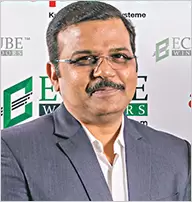
R. Srinivasan, Founder-Managing
Director, Mantralaya Impex
Choosing the right hardware is about ensuring that all components meet stringent standards, and their working together effortlessly, notes R. Srinivasan, Founder & Managing Director, Mantralaya Impex. Hardware should be chosen carefully for their reliability, technical performance, aesthetic appeal and value for money, he adds. It is natural that aesthetics gets importance along with the functionality and durability of products.
Hardware should be chosen carefully for their reliability, technical performance, aesthetic appeal and value for money, he adds. It is natural that aesthetics gets importance along with the functionality and durability of products.

Abhishek Bhaskar, Product
Manager-Architectural
Hardware, Hafele
Abhishek Bhaskar, Product Manager–Architectural Hardware, Hafele points out that wrong kind of hardware not only will render the door/ window inoperative but will also result in losses in terms of cost and time. While there could be specific factors that have to be considered for the selection of door and window hardware, three factors common to both are as under:
- Type of application
- Dimensions or specifications of the door or cabinet – weight, height, width and thickness
- Material and finish of the hardware – this is important as the hardware should suit the environment in which it is supposed to operate.

Karan Shah, Partner, PEGO
Hardware
Agreeing with Bhaskar, Karan Shah, Partner, PEGO Hardware also opines that right choice of hardware is very critical to distinguish a good window system from an ordinary one. For example, rollers are most critical for sliding windows & doors. Correctly load tested rollers compatible with the profiles will make the entire system functionally optimal, durable and easily usable.
Enquire Now for UPVC Sliding Doors

Rishi Gupta, Managing Director,
Kolf Safex
Rishi Gupta, Managing Director, Kolf Safex points out that selecting right hardware comprises the following factors: application – 60 per cent; aesthetics – 20 per cent and brand – 20 per cent. Brand is an important concern as it guarantees quality, safety and durability.

Nitin Agarwal, GM Architect
division, Gulshan Homz
Nitin Agarwal, GM – Architect Division, Gulshan Homz is very sure that he would go for a brand that is tried, tested and recommended by relevant consultants. They should be sturdy and maintenance free and easy to operate, he adds.

Sunny Gupta, Cofounder and
Managing Partner, De Frames
According to Sunny Gupta, Co-founder and Managing Partner, De Frames, along with design-oriented hardware preferences, one needs to see practical functionality and choose hardware by judging warranty and company performance. Profile of fabricator is also an important factor.

Ashutosh Mukherjee, Principal
Architect, Metamor-phosis
Architecture
Ashutosh Mukherjee, Principal Architect, Metamorphosis Architecture, observes that the industry is becoming increasingly design orientated with a growing number of companies coming up with solutions that are practical, sound and technically advanced, yet aesthetically appealing. Technology behind the product is also evolving, defining quality of the product in the eyes of the end user.

Joseph Fernandes, Head-Sales,
Q-Railing India Pvt. Ltd
Choosing a right product supplier over the available range of suppliers is easy, if the criteria is based on the quality and safety, points out Joseph Fernandes, Head – Sales, Q-Railing India Pvt. Ltd. The selection process would be easier if the products are tested and certified by recognised organizations.

Ar. Dipen Gada, Principal Archi-
tect, Dipen Gada Associates
The right kind of hardware must be chosen to protect the building from the climatic effects as also for safety and aesthetics of the building, says Ar. Dipen Gada, Principal Architect, Dipen Gada & Associates. He also notes that the criteria to select the right products are its durability, sustainability, texture, corrosion resistance, economical and design orientation. Choosing the right hardware should be influenced by the expected longevity and durability of the product. It is a fair assumption that any fenestration product, regardless of frame material, will last at least 40 years when correctly maintained!
Enquire Now for Window Frame & Profiles

Robert Hoellrigl, President-
Research Development – Design,
Encraft India Pvt Ltd.
One needs to differentiate between visible items (design orientated hardware) and non visible items (the necessary mechanics). Handles and hinges, the visible parts, are more appealing nowadays in terms of styling, ergonomics and finish, says Robert Hoellrigl, President-Research Development & Design, Encraft India Pvt Ltd. In the buying process, consideration must be given to those who would be operating the frame. The initial saving of a few thousands is soon forgotten and the daily operational struggle will remain, if the right one is not chosen!
How to Choose Right Hardware?
Hardware constitutes a meagre 1-3 per cent of the building cost. However, over a period of time, maximum issues arise due to malfunctioning of hardware, which can result in accidents and revenue loss, says Ankit Parikh of ASSA ABLOY. Hence, selection should be based on its quality, performance and longevity.
Compatibility is what defines the right hardware, says Karan Shah. It is the convergence of lot of variables; functionality, profile compatibility, durability, geographical location, load capacity and variable utility. For example, the utility of casement door hardware for a balcony door is very different from shaft door or kitchen utility exit door. Hence, the type of hardware to be used for all three would be very different even though they all are casement windows & doors in the same apartment with the same profile. One needs to create a checklist, specific for each types of doors & window. Along with using the right products, it is also very critical to ensure that they are installed properly, adds Shah.
Enquire Now for UPVC Casement Doors

Debjyoti Bose, COO, Saya Group
Debjyoti Bose, COO, Saya Group states that the hardware used must be functional as per design. The durability depends on the selection of the material of the hardware. They are also used for safety purpose which should be technically advanced and when these hardware are fixed, they should satisfy the aesthetic need of the building. Easy to use, easy to fix and appealing designs set a trend in the market. The common materials preferred for architectural hardware are Aluminium, metal, UPVC and wood. Sunny Gupta advices consumers to buy the doors & windows from reputed companies, who give warranty for the complete systems and not the profile alone.
According to Pramod Rao of Deceuninck, the key factors to consider are compatibility with the profile, corrosion resistance, cycle performance backed by proper testing and certification. “Being part of the UPVC Windows Doors Manufacturers Association (UWDMA), we are working on a guideline for selection of various hardware which should be out by end of this year. Currently the Guideline for Fabrication of UPVC windows and doors stresses on choosing products as per EN 13115 and EN 12217”, adds Rao.
Enquire Now for UPVC Windows
Joseph Fernande’s of Q-Railing explains that while selecting railing hardware, he would look into aspects like complete technical support from the manufacturer; indoor/outdoor application; locations like Staircase/Balcony/Atrium etc.; loading criteria with respect to footfall; wind load criteria; whether it is coastal area; maintenance requirements and provision of safety certificates from the supplier.
Robert Hoellrigl from Encraft advices that all hardware items should have at least the equivalent corrosion resistance of EN 1670:1998, grade 4 (240 hours) when subjected to neutral salt spray testing in accordance with EN ISO 9227.
Although, there is no direct correlation between a given number of hours salt spray testing and real-time natural environment exposure, it is good indicator in the selection process. Higher levels of corrosion protection i.e. EN 1670 grade 5 (480 hours) or austenitic stainless steel hardware can be specified for coastal or heavily polluted industrial environments.
It is a good practice to use critical hardware components for domestic applications like hinges, handles, rollers and locking devices which have been life cycle tested in accordance with EN 1191 (Windows and doors – Resistance to repeated opening and closing -Test method) and have achieved at least 20,000 (ten thousand) operating cycles (i.e. opening and closing) without deterioration, failure or excessive wear.
Consideration shall be given to the required operating strength of windows and door sets. uPVC fenestration can be designed with ergonomics and ease of operation in mind.
In hardware for façades, the most popular glass system in structural glass façades is the bolted version. The glass panel requires perforations to accommodate specialized bolting hardware. Cast stainless steel spider fittings are most commonly used to tie the glass to the supporting structure, although custom fittings are often developed for larger façade projects, says R. Srinivasan, Mantralaya Impex.
According to Abhishek Bhaskar, Hafele, the preference of the customers is shifting towards the use of concealed hardware that ensures minimal visibility and adds greatly to the aesthetic appeal of the interiors. The predominant material used in India is Stainless Steel 304. In coastal regions, people prefer using Stainless Steel 316. Zamac is still one of the preferred materials especially among the price-conscious sector. Pramod Rao, who is experimenting in corrosion resistant hardware, too recommends SS 304/316 material.
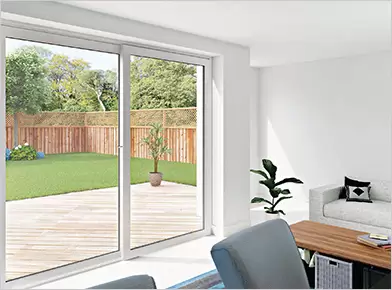 Wide Openings – a project by De Frames
Wide Openings – a project by De Frames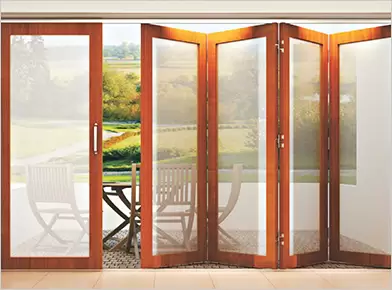 Casement Door by Encraft contemporary hardware
Casement Door by Encraft contemporary hardwareGlobally, clients want better performing, aesthetically pleasing façades and these requirements have to be delivered quickly and cost effectively. Hence the criteria for selection of hardware should depend upon the characteristics of the material. The availability of local service is an important criterion. Availability of skilled labour is essential for a good final finish, says Ar. Dipen Gada.
We can conclude that following aspects to be considered while selecting the right hardware for windows doors and façades (Based on the inputs from Profine India Koemmerling):
- Aesthetics and design compatibility performance
- Weight and height of doors & windows
- Wind pressure
- Integrated security features
- Durability
- Easy installation
- Low maintenance
- Corrosion resistance
- Span of windows/doors
- Height of the building
- Acoustical properties
- Better customer service
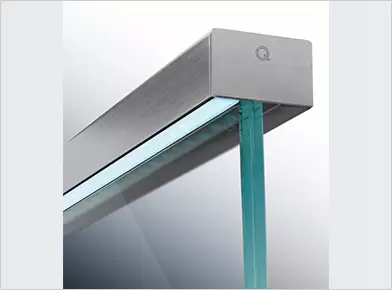 Railing with LED Liner lights from Q-railing
Railing with LED Liner lights from Q-railingEmerging Trends
Hardware designs and technologies have evolved and come a long way. Hardware manufacturers have invested in R&D to come up with hardware that is not only technically advanced but adds value to the looks of windows and doors.
Advancements in technology have enabled improved designs and given precision to products with quality and sustenance. The transparent building trend has been taking over in metropolitan areas over the past few decades, says Ar. Ashutosh Mukherjee, fuelling the designer’s interests to continue to push the boundaries of what is possible with lighter support structures, taller unsupported façades, and less hardware/connection points. Highly reflective glass and punched openings for buildings are thing of the past.
Architects look for the hardware which is concealed, agree Rishi Gupta, Nitin Agarwal and Robert Hoellrigl. At least they should be sleek and flexible. R. Srinivasan points out that the two main types applied in the industry for achieving transparency are tension rod façade s and cable net walls. Tension façades use high tensile cables or stainless steel rods to impose the loads of the façade on the main structure. This decreases the amount of solid structural elements visible on the project, therefore increasing the transparency of the façade.
The real trend is going minimal. Architects and customers alike do not want to see “bulky” hardware on their buildings/ doors etc. Less is more – is the latest trend yet delivering superior safety, security and convenience for the designers and users alike.
There are various categories of architectural hardware for various building types. In large commercial buildings, semi unitised and unitised Structural/ Curtain Glazing system with toughened glass is increasingly used for large open façades. In high-rise residential towers, the external doors and windows of the apartments are mostly in Aluminium or UPVC frames with clear float glass and in retail shop fronts toughened glass (without frames) with Stainless Steel patch fittings and door handles are in vogue, observes Debjyoti Bose. Sleeker patch fittings and door handles, are more in demand for better through visibility without infringement. For residential applications, neoclassical and other hybrid styles are making a comeback, and in alignment, varied styles of hardware for aldrops, tower bolts, mortice locks etc. are being used. An interesting trend is a combination of pure metallic finish with designer powder coating in hardware. Sunny Gupta observes that D-handle & L- handle are being more used by architects as they are more durable and practical.
Enquire Now for Door Handles
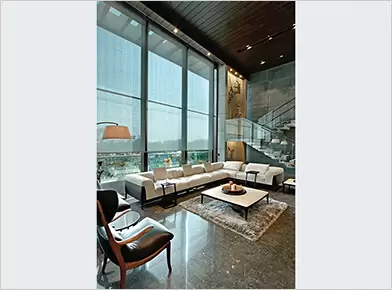 New innovations would focus on providing automated solutions. A project by Ar. Dipen Gada
New innovations would focus on providing automated solutions. A project by Ar. Dipen GadaAr. Ashutosh Mukherjee notes that the difference in choice of hardware is not in technology but is in design. While some spaces are content being functional, others evolve into aspirational art forms. Hardware is generally preferred to be engineered for long life cycles with low maintenance.
Hardware manufacturers cannot restrict themselves to the traditional aspects like functionality and durability, opines an expert from Koemmerling. In order to compete in the market, hardware manufacturers are differentiating themselves through value-added items.
According to Robert Hoellrigl and Ankit Parikh, the materials employed are mainly mild steel, Aluminium die cast and Zinc die cast for locking devices. A major breakthrough came with the use of injection moulding compounds, improved corrosion resistance and advanced finishing technologies like PVD-coatings (Physical Vapour Disposition). Visible hardware items can now cater for ultramodern fenestration and also for the traditional fenestration like typical, traditional Indian casements Talking about railings, Joseph Fernandes of Q-Railing observes that innovative glass patches or glass holders have been an interesting component of the railing design. However, very few companies have the safety certified components, which should be the main criteria of selecting railings. The most common material in railing industry is Stainless Steel Grade 304 /316 and glass. Demand for Aluminium is increasing due its light weight, structural strength and high quality finish while being economical.
Evolving Technologies
The role of windows and doors has changed to a large extent to provide water resistance, sound insulation, thermal insulation, energy efficiency, wind resistance, eco-friendliness, termite resistance etc. According to specialists from Koemmerling, all these roles can only be achieved by installing right hardware of latest technology. The essential door closers, rollers, handles, door locks , hinges and other accessories when installed, enable such roles to be achieved in the true sense of functionality.
Hardware manufacturers have been engaged in developing technologies that improve the functionality of windows and doors. Traditionally hardware products are manufactured by die casting, forging & extrusion processes. According to Karan Shah, though the basic process remains the same, the alloy used as raw material is evolving with better choices available. Other processes like powder coating and assembling are also going through substantial changes with more involvement of machines and less human interface. With advancements in manufacturing of products, more innovative ways are getting used to test various aspects of the products.
Experts from Koemmerling find a fully reversible window hinge with a unique patented dual function restrictor as a latest innovation. It offers dual functionality and seems to be the ideal choice for reversible residential and commercial upper floor windows. This hinge can be switched between anti-blowback and easy close functions depending on customer requirements.
According to Ar. Ashutosh Mukherjee, good products take into account not just the physical aesthetic but the very important kinaesthetic. Rishi Gupta of Kolf Safex observes that hydraulic products such as door closers and floor springs could be guaranteed up to 10 years, with improved technologies.
Enquire Now for Door Closers
Moving Towards Digitalization
Ankit Parikh spots that hardware is also moving towards digitalization. Atomization, monitoring, remote accesses and management are the latest requirements driving innovation. Security alarms integrated within window handles and connectivity to central security systems is picking up in Europe, observes Pramod Rao. It would trickle into India very soon though basic contact based security solutions are available.
Robert Hoellrigl too agrees that electronics have become part of fenestration. Operating windows or doors via telephone apps is not uncommon anymore. Electronically controlling and monitoring the living environment like opening/closing of windows and shadings; detection of smoke, gas, water, glass breakage, motion, etc. are some features which can be incorporated in today’s fenestration. “But it will need a major paradigm shift. People need to view today’s fenestration differently because modern fenestration has become a lifestyle choice!” adds Hoellrigl.
Abhishek Bhaskar is also certain that the advancements in technology will pave the way for complete home automation in future, which is seen only in hotels and commercial spaces today. Digital door security systems ensures complete safety and optimal functionality with digital door viewers and high-security digital locks that can be configured to multiple techniques of access control including RFID (card readers), Biometric (fingerprints) and Numeric (password entries).
Architects: The Trend Setters
Architects not only give focus on the functionality of the hardware but also on how it will resonate and provide aesthetically good looks to the building as a whole. The view and approach of an architect is very different from that of a fabricator or a hardware manufacturer, says Karan Shah. Ar. Ashutosh Mukherjee points out that architects tend to start from appearance rather than function, whereas product designers tend to work from function back to appearance.
For an architect, window & door is just one part of the complete jigsaw puzzle in the house or a commercial building, while for window maker or a hardware provider that is the only thing he has to look at. To satisfy the architect’s needs, window maker or a hardware provider starts focusing on the bigger picture – on ‘how they can ensure that their product satisfies the theme and utility desired by the architect’. Abhishek Bhaskar of Hafele agrees that architects often tend to concentrate on the design and finish of the hardware together with its functionality and hence require a lot of customization. Rishi Gupta and Sunny Gupta too agree that the suppliers must respect architects for their out of the box creations and thrive to give solutions for their needs by customising products.
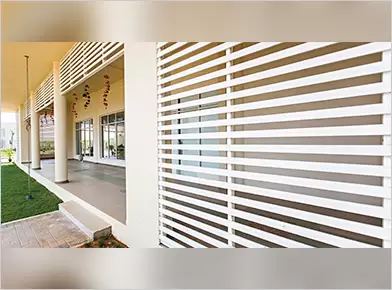 Shading System Mantralaya Impex
Shading System Mantralaya Impex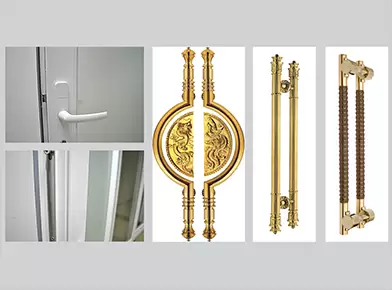 Hardware from Deceuninck & Kolf Safex
Hardware from Deceuninck & Kolf SafexArchitectural hardware manufacturers are bound to make customised hardware to architect’s needs, at the same time add value not just limited to functions of windows and doors but also to the interior of the house without compromising on quality and specifications. Thus architect’s inputs have led to innovative developments which will continue in the foreseeable future, notes Robert Hoellrigl. For example, the trend towards bigger openings with less frame and more glass necessitated the development of heavier profile systems and upgraded hardware to cope with the resulting weight increases. It is the vision of modern architecture that drives fenestration development and forces change!
Though there are a variety of aesthetically pleasing products, there is enough room for improvement in terms of finishing quality, product innovation and design considering Indian climate, wherein controlling heat transmission and humidity without compromising on light transmission would be very important, states Debjyoti Bose. This will, in turn save energy to a very great extent
Criteria for Choosing Hardware for Renovation Projects
A renovation cum maintenance project works within a defined scope and options. Since the installation of window/door has already happened, the options become limited, says Karan Shah of PEGO. It is important to focus on existing products already used in the door & windows since new products will have to cover the routing already done for the old ones. It is also important to note that the new product should not involve lot of onsite fabrication work.
In renovation projects, the main emphasis is ergonomics and durability, observes Hoellrigl. Prices are less sensitive but product finish and ease of operation are sometimes the deciding factors. On a one off basis, it is much easier to outline pros and cons and features beneficial to an individual customer. Whereas in volume project market, cost is the overriding factor.
Modularity and retro fitment play a bigger role in renovation projects. According to Ankit Parikh, renovations usually have faster turnaround times and hence universal fitting solutions are highly desired. Renovation projects are currently focusing on addressing the need of noise and thermal control. Every renovation project is unique and a general rule may be not be applicable. However focus again is on durability and performance tests, which are very important.
For railings, conventional designs must be replaced with modern, aesthetically elegant and safety certified railings.
Less anchoring to the floor or using fascia mount railing may increase area of usage. Glass railings are good option with desired safety for outdoor railings.
The Common Mistakes
Before one can even begin the hardware selection process, it is important to understand the factors particular to the installation which will affect their long-term performance. For most applications, these include life-safety, emergency egress, loss prevention and security for building occupants. Each of these factors should be examined for each application to determine the door’s performance level.
An important aspect to consider is the type of facility where the door is being installed. For example, doors installed in educational facilities, such as middle schools or high schools, will be subjected to an entirely different type and level of use and abuse than doors installed in a typical office or retail building.
One of the biggest mistakes involving door installation is the use of lightweight hardware on heavyweight or oversized doors. Undersized hardware will wear more quickly, resulting in misalignment of the door, difficult operation and security compromises.
Doors constantly exposed to high moisture levels, such as in facilities located in coastal areas, should have finishes and hardware that are highly resistant to corrosion. Without proper protective finishes, doors installed in this type of environment can fail in as little as five years. Door hardware that is not resistant to corrosion can stick and bind, making doors difficult to operate and eventually damaging the door, the hardware, or both. In dusty environments, dirt can load up on hinges and other door hardware and interfere with door operations, resulting in early failures. Standardization of replacement hardware components will reduce the size and cost of the inventory that should be maintained.
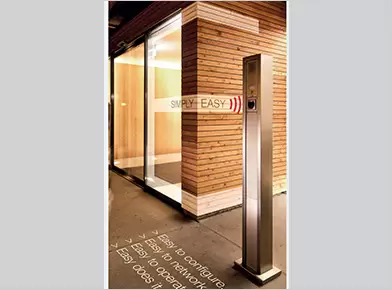
Hafele Hardware for larger projects like Hotels
Hurdles Faced by the Industry
According to Pramod Rao of Deceuninck, absence of standardization is a major hurdle in the industry. Everything else can be controlled if we bring in Standards for fabrication, installation and maintenance. Joseph Fernandes of Q-Railing too observes that lack safety standards and awareness among the clients as the major hurdles. Understanding codes & compliances is a battle, says Ankit Parikh from ASSA ABLOY.
R. Srinivasan of Mantralaya Impex dwells on logistical challenges. Installation of façade systems in high-rise buildings is a critical task with cascading challenges arising as a result of materials damage, nonavailability of transport at site and weather.
According to Robert Hoellrigl of Encraft, general availability and the reluctance to hold stocks of European hardware has become a major obstacle in India. It is widely accepted that ‘specials’ like lift & slide, fold & slide gearing etc., need to be imported. It will need only ‘one’ visionary European hardware supplier to demonstrate his commitment and stock and even manufactures fenestration hardware in India, adds Hoellrigl.
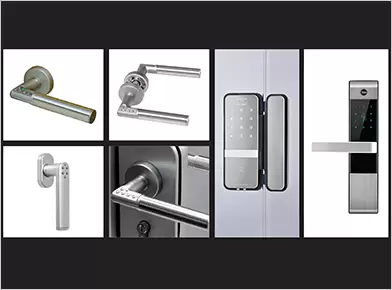 Hardware from ASSA ABLOY
Hardware from ASSA ABLOY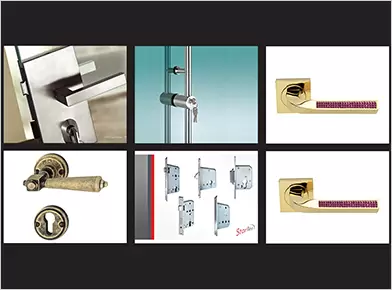 Hardware from Hafele
Hardware from HafeleOne of the challenges faced by Architectural Hardware brands is how to strike a balance between customization and cost effectiveness. Customization has a direct influence on the economies of scale thereby increasing the cost of manufacturing, spots Abhishek Bhaskar, Hafele. Keeping up with the fast-paced volatile market in terms of product design is another challenge, he adds. Therefore the stocks of these products need to be managed carefully.
Rishi Gupta perceives unorganized industry as a major hurdle. According to him, other obstacles are local importers, local manufacturing hubs, lack of standardised products and governing authority, lack of regulations or norms on products usage and application, etc.
Sunny Gupta finds Chinese suppliers selling products at low costs as a challenge. He points out that there is a need for government subsidies and benefits to encourage more people to introduce themselves to this industry.
Karan Shah from PEGO says that it is difficult to convince people about quality of Indian brands. Despite a variety indigenous brands, customers still go for imported products. Another problem is wrong installation of hardware by fabricators who are not technically equipped or trained, which results in below par performance of products. To address this issue, trained professionals should visit project sites to check the installation of hardware. The same will help to educate all the stake holders involved and in R & D of new products.
Future of Architecture Hardware Industry
The Hardware Industry has been growing steadily in the last decade. Rishi Gupta of Kolf Safex estimates the architectural hardware industry for façade s and fenestration to be more than 30,000 crores. “We thrive to be an important part of this industry though it is ruled by the major international players. Our industry is growing by the rate of 30 percent annually giving a boost to the GDP,” he adds.
In the early 2000 there were only one or two players, but today almost all leading global players are directly or indirectly present in India. In the next 5 years we can see many more quality players coming to India and a few starting to manufacture locally to control the logistics cost of import, says Pramod Rao, Deceuninck.
Robert Hoellrigl of Encraft also agrees that the growth is rapid. “India is a dream for any designer because traditional window and door designs change every 500 kilometres!” he adds.
According to R. Srinivasan of Mantralaya Impex, with the green building concept being given utmost priority, is increasing demand for hardware ensuring efficient façade and fenestrations systems that have thermal and acoustic insulation as well as aesthetic appeal.
Joseph Fernandes of Q-Railing is sure that in near future, the need for stainless steel and glass railings will grow along with light & strong structural aluminium railings. Standard certified systems will be accepted more over the uncertain customized railings. Green products will be more preferable in building industry, as in other sectors.
Karan Shah too finds the future bright. But this comes with lot of caution of using the right specs. It is important to educate clients, developers, consumers about the right hardware, correct choices, criteria, says Shah. There is a need for holding discussions and practical hardware installation sessions with various stakeholders to provide more awareness. A practical touch and feel experience, dummy door and window samples with all the necessary hardware inputs makes for easy and immediate understanding of products. He further adds that, with focus being on smart cities, there is big scope to concentrate on the untapped market which will be next step. Programmes like “Make in India” will give enthusiasm & motivation for small players to reach new heights & new business opportunities for the new emerging entrepreneurs, says Sunny Gupta.
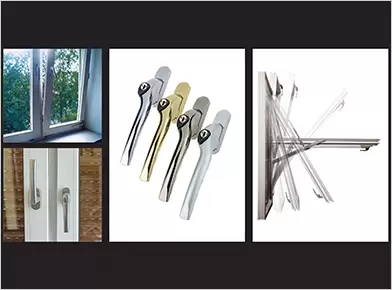 Hardware used in Koemmerling doors & windows
Hardware used in Koemmerling doors & windowsAnkit Parikh of ASSA ABLOY points out that the future is always subjective. “All I can say is that the trend to have more transparency in the buildings, bigger, wider and larger openings and the vertical expansion (high rises) all are the great drivers for the industry”.
Ar. Dipen Gada feels that constant R & D is needed in the hardware industries to provide solutions. Fortunately, it is happening in tandem with growth of the industry. New innovations would focus on providing automated solutions. He hopes that this would redefine the entire way of looking at door & windows, with more technological options it seems within reach.
The Indian Façade and Fenestration Industry is currently in an evolving state in terms of technology, size and installation capabilities, says Debjyoti Bose. Its growth is directly linked to the growth of construction industry which is around 20 percent. Also, there is an enormous space and extent for growth, given people in tier 2 and 3 cities are increasingly getting exposed to better products, apart from rapid urbanisation happening in vicinity of metropolitan cities. The future is bright and the focus needs to be on innovation and adaptation to requirements of the customer as also on sustainability and quality.

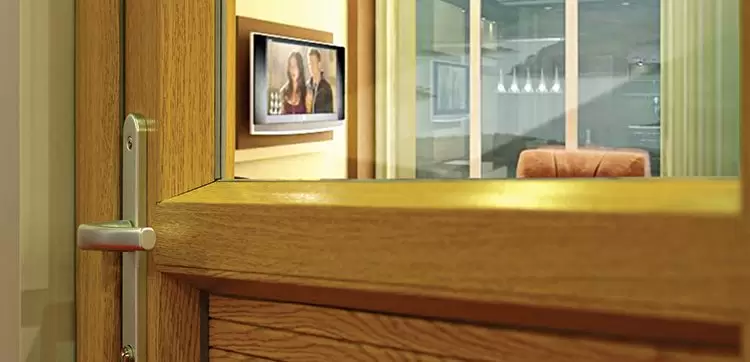
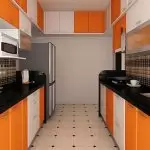
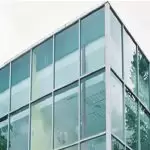
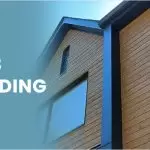


















Post A Comment